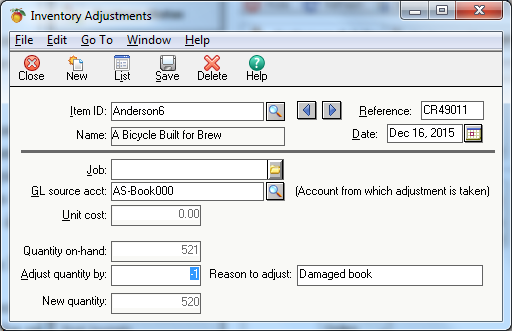| NESFA® Treasury Procedures — Table of Contents | Revised 21-Dec-2015 |
When a book becomes unsaleable at regular price because of damage, it can be sold as a
hurt book
at 50% of the original list price. A book is usually declared
as hurt when it is returned to us by a customer, but it can also happen when we notice
that a book is damaged in our stock, or at a convention sales table.
Any quantity of books can be indicated as hurt all at once, but it will take a number of Peachtree transactions equal to one more than the number of distinct titles involved.
For customer returns, use the CRyynnn credit memo number used to record the return as the reference number needed for an inventory adjustment transaction. From the Peachtree menu item Tasks, choose Inventory Adjustments. For each different title a new adjustment needs to be made. Enter the CR reference number, the book item, the quantity with a minus sign (because you are reducing the inventory of the original item), and (important) change the account designation from CG-bookname to AS-BOOK000. This will transfer the cost of goods from the original book's inventory account to the Hurt Books inventory account, and it reduces the inventory balance of the original book, but does not increase the inventory of hurt books. Save the transaction. Use the same reference number for all such adjustments from the same transaction.

Periodically, or perhaps aperiodically, buy in the hurt books as is done with any other book, using the account AS-BOOK000 and the inventory item Hurt Books. This part of the process could be done monthly, but what's important is that it be done prior to any convention or other event where we might actually sell some of the hurt books. When the hurt books are bought in, the quantity must be entered. This can usually be figured out by examining the report Reports & Forms > Inventory... > Inventory Adjustment Journal over the period since the last time the hurt books were bought in, and summing the appropriate entries.
Hurt books have barcode stickers which disregard the title and the original price of
the book and encode only the price. When scanned, these hurt books register in a
department
separate from our other books.
Originally, we had used barcodes with ISBN numbers that were not ours. Now
we use (non-ISBN) UPC-A barcodes in the range 401370000000 to 401370999999. Barcodes beginning
with the digit 4 are reserved for assignment by the store
using them.
The hurt books have the discounted price encoded in the 8th through 11th digits.
E.g., a book originally selling for $29.00, when hurt will have the barcode sticker
401370014503, indicating a reduced price of $14.50.
The club repealed the need to sell hurt books at 50%. They can be discarded, or sold for any reasonable amount. As a result, all the barcodes mentioned above will register as $0.00. If you want to sell a hurt book, you must enter the price and hit department key D03.
Thus, no discount key should be pressed, as the scanned code will produce a price which is
50% of the original cover price.
Even though, it is no longer required that hurt books be sold at 50%, if any are sold, the
total can be seen by turning the cash register mode key to OPX/Z mode and
depressing the department 3 key. When taking cash register readings for items sold,
a report can be generated for the hurt books by turning the key to X1Z1 mode and
entering 401370000000 @ 401370999999 UPC.